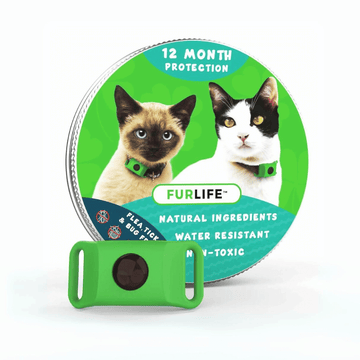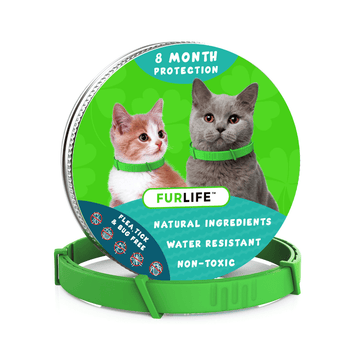Does Cedarwood Oil Kill Fleas on Cats?

![]() Sandra Tashkovska
•
Aug 04, 2025
Sandra Tashkovska
•
Aug 04, 2025
Cedarwood oil, or cedar oil, is often marketed as a natural flea remedy, but is it safe for cats? You might have heard about cedarwood oil from DIY pet care videos, or maybe as an ingredient in flea sprays or shampoos, followed by claims that it is a safe, natural way to fight fleas. But is it?
Here is the catch - Cats have a different way of processing certain substances, compared to dogs or humans, and are more sensitive to pantry items that are harmless for others. What could be a small dose of a certain material can be lethal to cats. This includes cedarwood and other essential oils.
In this article, we will separate fact from fiction and guide you through what cedarwood does to a cat's body, the potential risks it holds, and why it isn't a good method for stopping a flea infestation. We will also show you a good, natural-based alternative - FurLife and our anti-flea products for cats!
Why Cats Need Extra Care with Essential Oils
We already mentioned that essential oils and cats don't mix. That is because cats lack a specific liver enzyme called glucuronyl transferase, which is responsible for breaking down different plant compounds. Without this enzyme, these compounds build up in the cat's system and can lead to possible toxic effects.
When it comes specifically to cedarwood oil and its compounds, the way a cat's body reacts depends heavily on both the genetic and individual factors and the brand of oil. Compared to other oils, like tea tree oil, it is safer. But that is only when it is diluted correctly and is low in phenols!
Phenols are chemical compounds that are found in plants and other microorganisms. They can't be metabolised by a cat's system because of the lack of the aforementioned enzyme. By diluting cedarwood oil, the percentage of phenols also lowers. But, this dilution doesn't make it safe, as some cats still react badly - they drool, cough, and could develop skin rashes. More severe cases even lead to tremors or seizures.
The bottom line is that you should always be cautious with any essential oils near your cat, even if they are "pet-safe".
Myth vs Reality: Cedarwood Oil & Fleas
Because of its popularity as a DIY item, many pet owners believe that cedarwood oil for fleas on cats is an effective deterrent. Let's see what the experts have to say about this:
-
Catster states that using cedar oil could lead to fleas being repelled or killed, but they advise consulting a vet before trying it on your cat.
-
Pet Wellness Direct recommends diluting it in water and being very careful of how often you use it. Misusing this dilution could cause harm to your cat.
-
Forums like Reddit have posts from veterinarians that report that cedarwood oil repels fleas, but doesn't kill them
If you have more pets, including a dog, you can learn more about the effect that cedarwood oil has on them and compare the differences between them and cats. Learn more in this article!
Key Takeaways:
-
Cedarwood oil might repel fleas, but it rarely kills them in any life stage.
-
Depending on the brand and dilution level, its effectiveness varies. Those with a high phenol content can be especially toxic to cats.
-
Cats are aversive to the strong smell of cedarwood oil
-
Many side effects can happen if overexposure occurs - the cat's skin might become irritated, they begin to cough and drool, and in extreme cases, develop neurological symptoms like seizures.
Flea Life Cycle: Why Repellent Alone Isn’t Enough
You might be wondering what we mean when we mention all the life stages of the flea. Fleas are known for being good at hiding.
Those fleas that you see running around your cat's fur are adult fleas, which feed from your cat and copulate. After copulating, fleas lay eggs. These eggs are everywhere, not only on your cat. They can be found in carpets, bedding, and furniture, but since they are very small, they are hard to spot.
Eggs are the first life stage of the flea. After falling off your cat somewhere in the environment, they have become larvae. These larvae hide in dark spots, like under the sofa or in the flooring, and feed on organic matter. After some time, they spin a cocoon and become a pupa. The pupae are the most persistent stage, and it is the hardest to get rid of entirely. Adult fleas emerge from the pupae and then jump back onto your cat, beginning the cycle all over again.
In the best cases, cedarwood oil repels adult fleas from hopping on your cat, but it doesn't stop the cycle. That means that the flea problem will come back after the effect of the oil wears off.
Vet-Recommended Flea Control for Cats
Now that we know that cedar oil isn't useful in getting rid of fleas, here is a vet-recommended layered protection routine. This routine is safe and tailored for cats.
Prescription Preventives
The first step of this routine is using vet-approved treatments. These treatments are designed to affect the flea's entire life cycle and prevent reinfections.
There are two types of treatment - oral and topical. Oral treatments are vet-prescribed and are given to your pet by mouth, while topical treatments can be found both in veterinary clinics and pet shops. Some are even available online, like FurLifes products.
Mechanical Approaches
Aside from using a vet-approved treatment, bathing, and removing fleas through combing are also crucial in minimizing their numbers. Bathing and combing are effective only when combined with some treatment, not as a standalone fix.
While dealing with an infestation, veterinarians recommend bathing your cat once a week with a special vet-approved shampoo, which is not harsh on the cat's skin. These shampoos help in detaching fleas from the cat's fur, killing them, and making it easier to remove them with a comb.
By combing your cat daily, you remove both dead and alive adult fleas from their fur, which leads to an increase in their overall well-being and health.
Environmental Hygiene
The last step of this routine is maintaining a solid level of environmental hygiene. Did you know that only 5% of fleas live on your cat, while the rest are all scattered around the household?
To get rid of them entirely, it's important to target not just your cat, but the cats' living environment. Vet recommends cleaning regularly by:
-
Vacuuming daily - The vibrations cause adult fleas to emerge from the pupa, but they die shortly after since a host isn’t around.
-
Washing pet bedding once a week
-
Using enviormental sprays
Where Furlife Fits: Better, Safer, More Effective
Furlife is a company made by animal lovers for animal lovers. Together with vets and researchers, we develop products that offer a smarter solution to flea infestation.
Why choose Furlife? Our products are tailored for cats and their unique biology. During production, veterinarians actively take part to make sure that everything is correctly dosed and entirely safe for cats. Furlife is also more convenient - our products last from a month to up to a year, and are easy to apply - there is no messy DIY routine and no hazard for both you and your cat.
Depending on the individual needs of our buyer and their cat, we have different products aimed at their comfort. Our products range from:
-
FurLife™ - 8 Months Flea and Tick Collar for Cats - A stylish collar on first glance, but extremely effective in killing and deterring fleas. This product is based on natural essential oils and offers up to 8 months of protection against fleas and ticks.
-
FurLife™ - 12 Months Flea and Tick Tags for Cats - For the felines that dislike wearing a flea collar, we have pendants. These pendants are easy to attach to your cat's regular collar and offer the same benefits as the collar - they work against fleas, ticks, and last year-round.
-
FurLife™ - Flea & Tick Spray for Dogs and Cats - If your cat lounges outside from time to time, this product is ideal to combine with either the collar or pendant. Instead of bathing your cat, spraying it with this spray repels and kills any fleas, ticks, or bugs that might have accidentally attached to their fur. The smell isn’t as potent as diluted cedar oil, making it less aversive to cats.
|
Feature |
Cedar Oil |
FurLife Flea Products |
|
Kills eggs and larvae |
No, only repels a few adult fleas |
Yes, it affects the full flea lifecycle |
|
Vet-approved |
Minimal, and only if properly diluted |
Specially formulated for cats |
|
Safety risk |
Possible skin and respiratory system irritation |
Skin tests and formulated alongside vets |
|
Convenience and consistency |
Needs frequent reaplication |
From a month to up to a year, depending on the product |
|
Reliability and residual action |
Short-lived |
Long-term protection |
Supportive DIY Tips
If you are still considering using cedarwood around your cat, here are some tips to make it safer for them:
-
Cedar chips - Opt for cedar chips instead of cedar oil. Place the chips near bedding and outdoor areas to deter the fleas.
-
Flea combing - Brush your cat daily with a flea comb to remove adults. Drop the fleas and clean the comb afterward in soapy water.
-
Targeted washing - Bathe your cat in cat-safe shampoo.
-
Environmental spray - Use Furlifes spray on bedding and furniture after cleaning to help deter fleas.
Pay close attention to your cats in case signs of irritation surface. If any appear, stop using cedarwood oil or cedar chips immediately! Depending on the severity of symptoms, visit your vet to check your cat's health.
FAQ Section
Does cedarwood oil kill fleas on cats?
At best, cedarwood oil can repel adult fleas from your cat's fur until its fragrance wears off. Cedarwood oil also doesn’t affect the other life stages of the flea, which means that after some time, the flea infestation comes back.
Is cedarwood oil safe for cats?
The safety of cedarwood oil depends on its phenol concentration levels and whether it is diluted properly. The concentration varies between brands, which means that some are more toxic to cats than others, making dilution essential. It is also advised to consult a vet before using cedarwood oil on your pet.
Can it prevent reinfestation?
No, cedarwood oil does not stop the flea's life cycle; it only repels them from your cat's fur for a short time. After its effect wears off, reinfestation occurs again.
Are any essential oils safe for fleas on cats?
Very few essential oils are considered cat-friendly. Cedarwood is considered one of the safer variants, but it is not entirely safe. This is because cats lack a liver enzyme that metabolizes special compounds found in plants, known as phenols. When overexposure to phenols occurs, they build up in your cat's system and lead to signs of toxicity.
What’s the most effective flea control for cats?
Vet-approved flea treatments, like FurLife, are considered the best and most effective ways to get rid of fleas. Combining that with regular house cleaning, it becomes easy to keep fleas away from your pet and home.
Summary
Cedar oil might sound like a fast and natural fix against fleas, but it is no silver bullet. At best, it can repel a small number of fleas, and at worst, it can lead to signs of intoxication in your cat!
Instead of making your own diluted sprays and hoping for the best, choose something safer and stronger - Furlife!
Furlife's flea control products are formulated to be safe for cats, but harsh against fleas, affecting all life stages. In their development, research work back to back with veterinarians to assure the best for both you and your cat - A comfortable cat and a clean home. Skip the guesswork and choose one of our products today!









